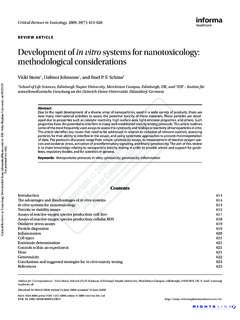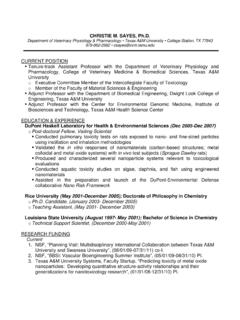Transcription of Effect of silver nanoparticle surface coating on ...
1 nanotoxicology , 2010; Early Online, 1 13 Effect of silver nanoparticle surface coating on bioaccumulation andreproductive toxicity in earthworms (Eisenia fetida)WILLIAM A. SHOULTS-WILSON1, BRIAN C. REINSCH2, OLGA V. TSYUSKO1,PAUL M. BERTSCH1, GREGORY V. LOWRY2, & JASON M. UNRINE11 Department of Plant and Soil Sciences, University of Kentucky, Lexington, KY, and2 Department of Civil andEnvironmental Engineering, Carnegie Mellon University, Pittsburg, PA, USA(Received 11 August 2010; accepted 29 October 2010)AbstractThe purpose of this study was to investigate the Effect of surface coating on the toxicity of silver nanoparticles (Ag NPs) (Eisenia fetida) were exposed to AgNO3and Ag NPs with similar size ranges coated with either polyvinylpyrro-lidone (hydrophilic) or oleic acid (amphiphilic) during a standard sub-chronic reproduction toxicity test.
2 No significant effectson growth or mortality were observed within any of the test treatments. Significant decreases in reproduction were seen inearthworms exposed to AgNO3, ( mg kg-1) as well as earthworms exposed to Ag NPs with either coating ( mg kg-1for oleic acid and mg kg-1for polyvinylpyrrolidone). The concentrations of Ag NPs at which effects were observed aremuch higher than predicted concentrations of Ag NPs in sewage sludge amended soils; however, the concentrations at whichadverse effects of AgNO3were observed are similar to the highest concentrations of Ag presently observed in sewage sludge inthe United States. Earthworms accumulated Ag in a concentration-dependent manner from all Ag sources, with more Agaccumulating in tissues from AgNO3compared to earthorms exposed to equivalent concentrations of Ag NPs.
3 No differenceswere observed in Ag accumulation or toxicity between earthworms exposed to Ag NPs with polyvinylpyrrolidone or oleic :Eisenia fetida, silver nanoparticles , reproductive toxicity , bioaccumulation , X-ray absorption spectroscopyIntroductionSilver nanoparticles (Ag NPs) have become an inte-gral component in a wide array of consumer products(Klaine et al. 2008; Luoma 2008). Products currentlybeing produced that utilize Ag NPs include medicaldevices, food-storage containers, soaps and sanitizers,wound dressings, and fabrics; Ag NPs are frequentlyutilized in polymeric, colloidal, spun and powderforms (Luoma 2008). With greater Ag NP productionand incorporation into consumer products, it isexpected that Ag NPs will provide an increasingcontribution of anthropogenic Ag into the environ-ment (Blaser et al.)
4 2008). Much of the Ag fromfabrics is expected to enter the wastewater streamand eventually treatment plants in dissolved ornano-particulate form (Benn and Westerhoff 2008)where an estimated 90% will be removed from thewaste stream and partitioned to sewage sludge(Blaser et al. 2008; Mueller and Nowack 2008;Gottschalk et al. 2009). The sludge-associated AgNPs may be disposed of through incineration, land-filling or application to terrestrial environments asbiosolids, depending on the prevailing practices ofthe country or region (Mueller and Nowack 2008). Inthe United States and much of Europe, approximately60% of sewage sludge is applied to agricultural landsas biosolids (United States Environmental ProtectionAgency [USEPA] 2009). Thus, this represents apotential exposure pathway to terrestrial organismsof high increased production of Ag NPs, relativelylittle is known about their environmental fate andpotential effects, particularly in terrestrial environ-ments (Klaine et al.
5 2008; Unrine et al. 2008). Thetoxicity of Ag NPs has thus far been mainly studied inthe aquatic environment, with toxicity demonstratedfor bacteria (Morones et al. 2005; Panacek et al. 2006;Choi et al. 2008; Choi and Hu 2008), yeast(Panacek et al. 2009), paramecia (Kvitek et : Dr Jason Unrine, Department of Plant and Soil Sciences, University of Kentucky, N212-N Agricultural Science Center North, Lexington, KY40546, USA. Tel: +1 859 257 1657. Fax: +1 859 257 3655. E-mail: 1743-5390 print/ISSN 1743-5404 online 2010 Informa UK, : Downloaded from by Young Library on 12/13/10 For personal use ), algae (Griffitt et al. 2008; Navarro et al. 2008),daphnia (Griffitt et al. 2008), Japanese medaka(Chae et al. 2009), fathead minnow embryos(Laban et al. 2010), and various zebrafish life stages(Lee et al.
6 2007; Asharani et al. 2008; Griffitt et ; Yeo and Kang 2008; Bar-Ilan et al. 2009). Inthe terrestrial environment, Ag NPs have not beeninvestigated to such an extent and Ag toxicity itselfis not well studied (Ratte 1999; Nahmani et ). The soil nematodeCaenorhabditis elegans(Rhabditidae, Maupas 1900) has been used to assessAg NP toxicity but these experiments were performedin K-medium (NaCl and KCl solution) rather than insoils (Roh et al. 2009). To address the need for anunderstanding of the terrestrial toxicity of Ag NPs, thecurrent study investigated the toxicity of Ag NPs insoil to a model soil organism, the epigeic earthwormEisenia fetida(Lumbricidae, Savigny 1826).Another aspect of Ag NP toxicity that has not beenextensively examined is the role that the NP surfacechemistry ( coating ) plays in toxicity .
7 Several studieshave shown differences in toxicity (Griffitt et al. 2008;Navarro et al. 2008; Bar-Ilan et al. 2009; Kvitek et ; Panacek et al. 2009) and transcriptomicresponses (Roh et al. 2009) between Ag NP andAgNO3, with ionic forms typically exhibiting greatertoxicity. However, Ag NPs have different surfacechemistries depending on coating or functionaliza-tion, which may alter their toxicity and/or mode ofaction. For instance, Ahamed et al. (2008) found thatAg NP particles coated with polysaccharidescaused greater damage to mammalian cell linesthan similarly-sized Ag NP that were uncoated. Pre-vious studies also suggest that Ag NPs stabilized withsurfactants cause greater toxicity to microorganismsthan unmodified Ag NPs (Kvitek et al. 2009;Panacek et al. 2009). In contrast, zerovalent ironnanoparticles have been shown to be less toxic tobacteria when coated with polymers or natural organicmatter (Li et al.)
8 2010).It is unclear if these differences in surface chemistryare important determinants of toxicity in environmen-tally realistic exposure scenarios, such as in soil. Forexample, it is widely acknowledged that naturallyoccurring colloids in soil environments are coatedwith substances such as iron oxohydroxides and nat-ural organic matter (Bertsch and Seaman 1999).Therefore, engineered surface coatings may be exten-sively modified in the natural environment, and theproperties of pristine coatings may become lessimportant in terms of bioavailability and , if toxicity is primarily related to therelease of free Ag ions, then surface coatings mayonly be important as they relate to oxidation objectives of this study were: (i) To determineconcentrations of Ag (both ionic and nanoparticulate)that caused adverse effects onE.
9 Fetidagrowth, mor-tality and reproduction, and (ii) to determine whetherAg NP toxicity could be influenced by surface chem-istry. In order to achieve this, we performed standard-ized reproductive toxicity tests (Organisation forEconomic Cooperation and Development [OECD]2004) onE. fetidaexposed to various concentrationsof ionic Ag and Ag NPs in artificial soil media. The AgNPs were coated with either polyvinyl pyrolidone(PVP) or oleic acid (OA). The PVP-coated Ag NPsare hydrophilic, primarily forming stable suspensionsin polar solvents (Yan et al. 2009), while OA-coated Ag NPs are amphiphilic, forming stable sus-pensions in polar solvents, non-polar solvents orpolar/non-polar interface layers depending on pH(Li et al. 2002; Seo et al. 2008). The log Kowvaluesof PVP and OA are and , respectively(BASF 2008; International Programme on ChemicalSafety [IPCS] 2010; in press).
10 Therefore, comparingthe two should provide an understanding of theimportance of surface chemistry in Ag NP toxicitytoE. fetidaunder an environmentally relevant expo-sure and methodsMaterial characterizationSilver powders, each with a stated nominal sizedistributions of 30 50 nm, with polyvinylpyrolidone(PVP) and oleic acid (OA) coatings were purchasedfrom NanoAmor (Nanostructured & AmorphousMaterials, Inc; Houston, TX, USA). The powderswere both high purity (>95% Ag), which we verifiedby dissolving in concentrated, ultra-high purityHNO3and analyzing for metallic impurities usinginductively coupled plasma mass spectrometry (ICP-MS; see description of methods below). Primaryparticle diameter distributions were determinedusing transmission electron microscopy (TEM) asdescribed in detail in (Shoults-Wilson et al.)









